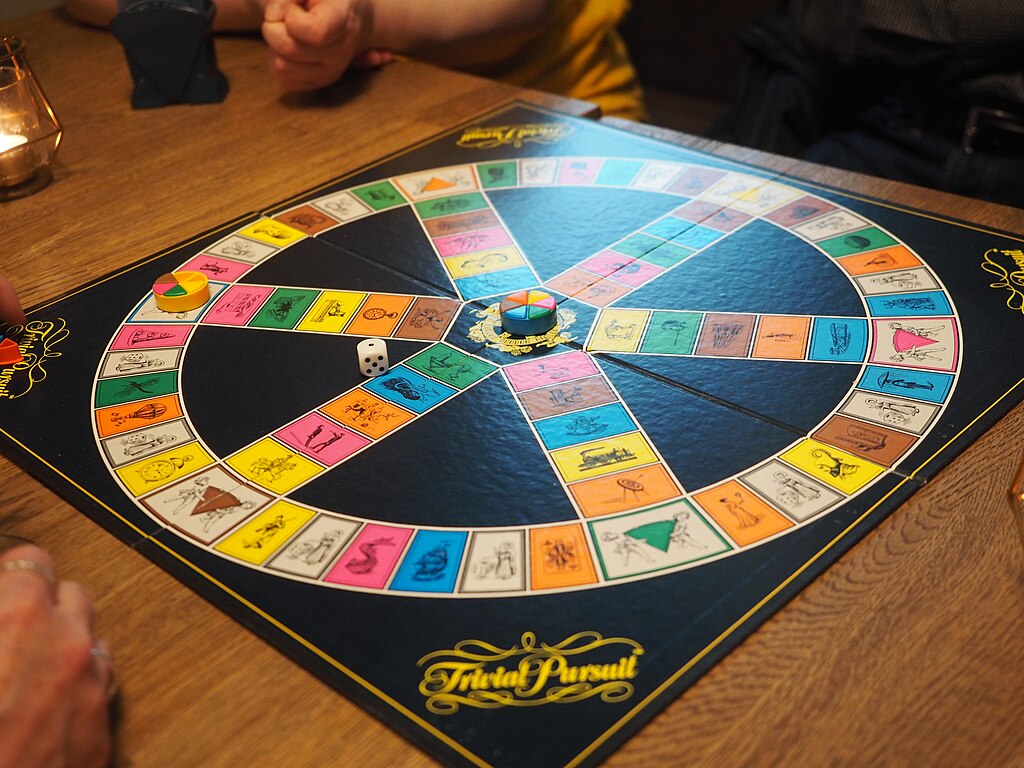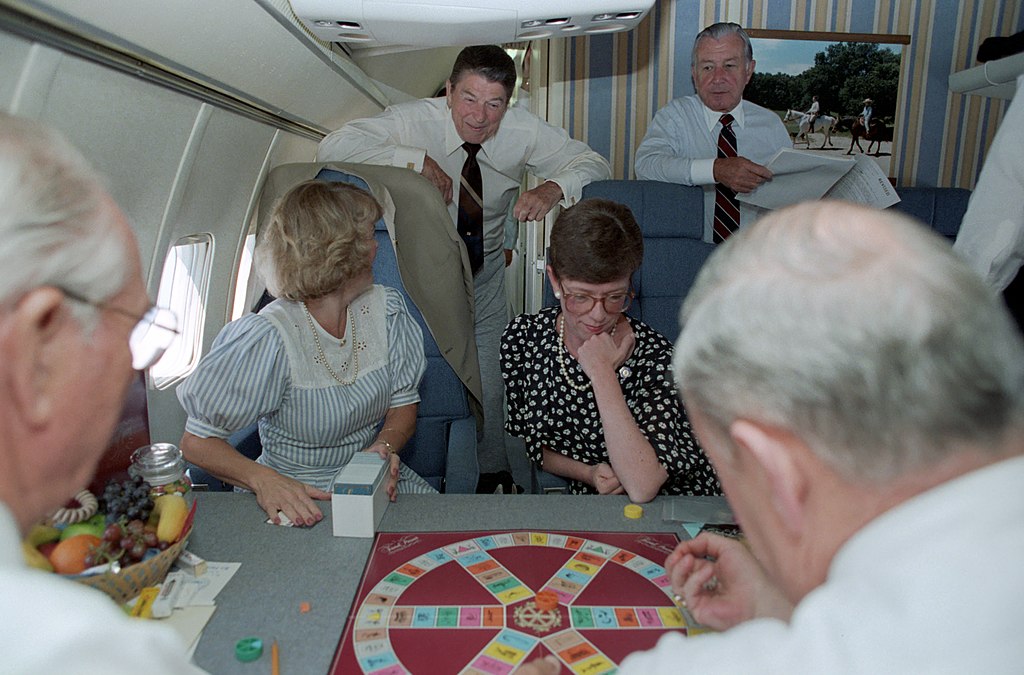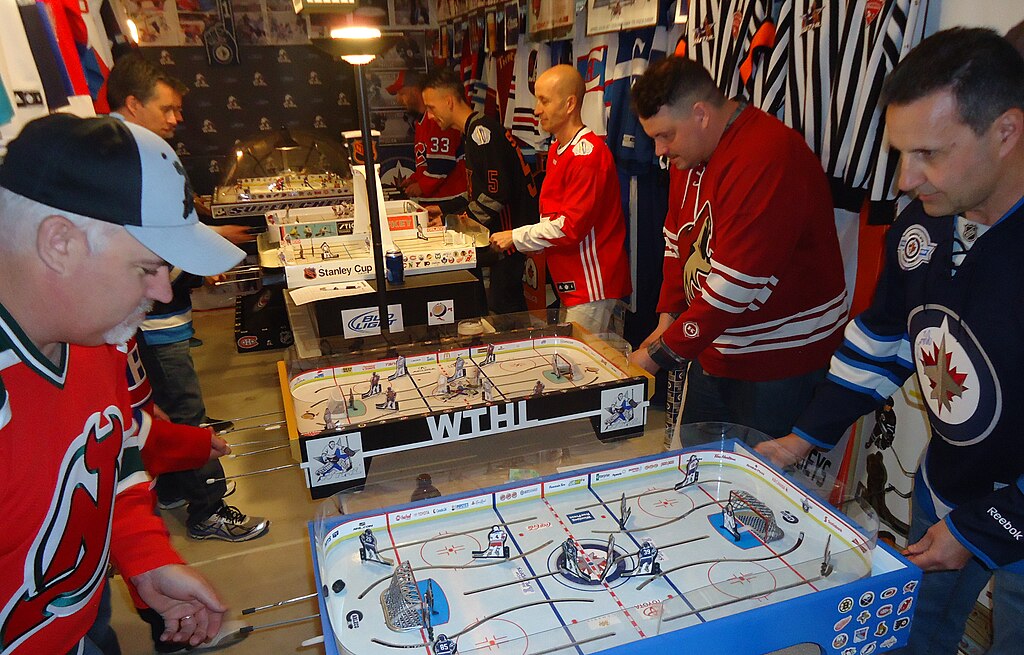Trivial Pursuit is a board game that was invented by Canadians Chris Haney and Scott Abbott in December 1979. The game quickly became a massive international success and a defining pop culture artifact of the 1980s. It ushered in a new wave of board game popularity and was called “the biggest phenomenon in game history” by Time Magazine. First introduced in Canada in 1981 and in the United States in 1982, the game had sold more than 20 million copies by 1984. Total sales are estimated to have exceeded $1 billion and more than 100 million copies worldwide. The game is named after a common term for a frivolous activity (like a board game), which also literally describes the nature of the game (players answer trivia questions in pursuit of the most correct answers). Trivial Pursuit has been translated into multiple languages and re-issued in numerous editions.

Gameplay
Trivial Pursuit can be played by two to six players (or teams of players). Each player advances around the board using a circular token with six empty, triangular spaces — like a pie with pieces missing. Each player rolls a die to advance their token the corresponding number of spaces, landing on tiles in one of six colours. The colours correspond to one of six trivia categories: sports and leisure (orange); history (yellow); geography (blue); entertainment (pink); science and nature (green); and arts and literature (first brown, later purple). A correct answer earns the player a corresponding colour triangle, or pie piece, that fits into the token. A correct response also allows the player to roll again, while an incorrect answer results in a change of turn. The objective is to be the first player to correctly answer a question in each category and earn all six colours. Game time varies, though it is estimated to be roughly 80–90 minutes.
Background History
Chris Haney and Scott Abbott were both working as journalists in the late 1970s. Haney was born in Welland, Ontario, around 1951. His parents met in the United Kingdom during the Second World War. (His father was a Canadian soldier, his mother a sergeant in the territorials.) Haney dropped out of high school at age 17. His father worked for the Canadian Press and got him a job as a copy boy. He later took over the photo desks in Montreal and Ottawa and eventually became a photo editor with the Montreal Gazette.
Scott Abbott was working as a sports journalist for the Canadian Press. Haney and Abbott met in 1975 when Haney arrived in Montreal to set up the Canadian Press’ coverage of the 1976 Olympic Summer Games.

Haney and Abbot devised the game on the afternoon and evening of 15 December 1979. Many rumors have circulated over the years about the context of the game’s creation. Haney and Abbott have refuted rumors that the game was created in a bar, or that they were inebriated at the time of its conception. (A 1988 CBC TV movie about the game’s invention, Breaking All the Rules, depicted Haney and Abbott as beer-drinking hosers who created the game in a downtown strip club on their lunch breaks.)
Rather, the pair were playing Scrabble in Haney’s home in Montreal one evening and discussed whether they could create as good a game. The discussion came about after Haney realized he had purchased his sixth game of Scrabble (possibly because of missing pieces) and wondered aloud whether he and Abbott could come up with a similarly successful game. Haney asked Abbott what the game could be about, to which Abbott answered “trivia.” Haney and Abbott came up with the basic idea of the game — a trivia board game with questions divided into six broad categories — in a few hours.
Game Development
As they developed the game, Haney and Abbot realized they needed to get more information about the design, development, production and marketing of board games. They decided to go to a Montreal toy fair posing as a reporter-photographer team working on a story. Haney recalled that they left the fair with “$10,000 worth of information.”
The duo brought on two more people to help them with the business development of their endeavour: Chris Haney’s bother John, a former professional hockey player; and John’s friend Ed Werner, a corporate lawyer.
The four then began working on raising funds to produce the game. They devised a plan where they would offer shares to friends and family for a $1,000 investment. This was not so straightforward a proposal. In addition to the considerable start-up investment they were seeking, the market for board games was not especially dynamic in the late-1970s and early-1980s. Action figures dominated the toy market, and video and computer gaming was moving from arcades into people’s homes. In addition, some people thought Haney and Abbott were con men, because they had once created a successful chain-letter scheme. Despite these obstacles, they ultimately raised $40,000 from 32 investors. Haney said in a CBC report from 1982 that it was thanks to a bank manager in St. Catharines, Ontario, who had played the game, that they secured additional financing. It took the pair about two years to come up with the 6,000 initial questions and receive enough orders for the initial production run.
Phenomenal Success
Haney and Abbott were not initially successful marketing and selling their game at toy fairs in Montreal and New York. But it wasn’t long before it became a runaway success. The game was introduced in Canada in 1981 and made Haney and Abbott millionaires by 1982. This was achieved almost entirely through word of mouth.
By 1982, the production line in Canada was assembling 3,500 games per day, all of which were sold as soon as they hit store shelves. The game sold 100,000 copies in Canada by the end of 1982. Games were moving off the shelves so quickly stores had difficulty keeping them in stock. It was a notable small-business success story amid the economic recession of the early 1980s. The game was introduced to the United States in 1982, and by 1984 20 million copies had been sold. That figure quadrupled by 2004.
Once distribution in the US began in 1982–83, Trivial Pursuit quickly became an iconic element of American popular culture. By 1984, Trivial Pursuit parties had become more popular than dinner parties in New York City. The cast of the film The Big Chill (1983) was reported to enjoy playing the game between takes. Trivial Pursuit was named to the Games Hall of Fame in 1993.
In 2008, Haney and Abbott sold the game’s rights to Hasbro for $80 million.

Spinoffs and Other Media
There are many iterations of the basic game. Numerous new editions have been created over the years with updated trivia. In addition, there were at least 50 special editions of Trivial Pursuit published by 2014. It has been produced as a home video game, as an arcade game, and as an online game.
In addition to the board game, TV game shows based on Trivial Pursuit have been produced and broadcast in the United States, the United Kingdom and Spain. A Trivial Pursuit game show hosted by LeVar Burton went into development in 2021 and was set to premiere on the CW Network in October 2024. It was scheduled to immediately follow a Scrabble game show.
Lawsuits
Over the years, the game survived two lawsuits. In 1984, author Fred L. Worth filed suit, arguing that he was owed money because Haney and Abbott referenced trivia he had accumulated in his trivia books. A judge later determined that trivia couldn’t be stolen.
In another case that lasted 13 years, David Wall, a Canadian from Nova Scotia whom Haney had once picked up hitchhiking, claimed that he had in fact given Haney the idea for the game. But a judge didn’t buy Wall’s claim.
(See also Toys and Games.)

 Share on Facebook
Share on Facebook Share on X
Share on X Share by Email
Share by Email Share on Google Classroom
Share on Google Classroom


